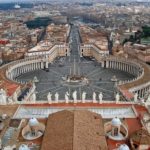The recognition of the new entity called Vatican City, following the Lateran Agreements of 1929, created a new independent state: an elective absolute monarchy, with the Pontiff embodying three powers: legislative, executive, and judicial, as well as international legal personality.
It is an “atypical state,” and its small territory serves the Holy See for the exercise of its universal mission, whose objectives are not territorial, as in all other states, but spiritual.
The Holy See, as an institution, is the apex of the Church, and it is “constituted” by the Roman Pontiff, the congregations, the tribunals, and the central services that form the Roman Curia. Organized in a highly structured manner, Vatican City is also home to three “financial entities”: the Prefecture for Economic Affairs (Ministry of Economic Affairs), APSA (Administration of the Patrimony of the Apostolic See), and IOR (Institute for the Works of Religion).
APSA administers the Holy See’s assets to provide the necessary funds for the management of the Curia (it is a kind of central bank).
The IOR traces its roots to the Commission for Pious Causes, created in 1887 by Pope Leo XIII.
With the financial agreement attached to the 1929 Concordat, the Italian state recognized its debt to the Holy See for annexing the Papal States and confiscating church property, and paid compensation of 750 million lire in cash and Italian government bonds worth one billion dollars, equivalent to over €700 billion today.
To manage this patrimony, Pope Pius XI established the Special Administration for the Works of Religion, relying on a highly respected banker, engineer Bernardino Nogara.
It is said that Nogara himself set a condition for acceptance: that the chosen investments be completely free from any religious considerations and have the freedom to invest anywhere in the world.
On June 27, 1942, Pope Pius XII changed the administration’s name to the Institute for the Works of Religion (IOR).
Thus was born the Church as an institution functioning like a bank, endowed with independent legal personality, which provides for the “deposit and administration of movable and immovable assets of the Church,” but also manages money and assets transferred or ceded by individuals or entities or dioceses for the purpose of “works of religion and Christian charity.”
The IOR, based in the Vatican, has never published a report or public statement of its activities. The institute is audited by Price Waterhouse (Geneva) and manages assets estimated at €5 billion, and this year has given €49 million to the Pope to support “his apostolic and charitable ministry.”
Until recently, the bank did not comply with anti-money laundering regulations, although over the years, under the management of Professor Angelo Caloia, whose long term ended in 2006, steps were taken in this direction with the introduction of international protocols (the “KYC”), which allow a series of sensitive data about clients to be discovered.
The bank, however, has a cluttered past. The scandal of Banco Ambrosiano (which led to the bankruptcy of this bank very close to the Milan diocese) under Bishop Paul Marcinkus’s management in the 1980s and the recycling of a colossal bribe from the Enimont case in 1992 during Prelate Donato De Bonis’s administration are just examples.
To get off the international blacklist in 2011, the Holy See adopted legislation against money laundering and terrorism financing (law 127 of 01/04/2011), requiring oversight by Moneyval (the Committee for the Evaluation of Anti-Money Laundering and Terrorism Financing).
The report cites 49 recommendations from the FATF MONEYVAL-FATF (Financial Action Task Force of the International Monetary Fund). Of the 45 recommendations applicable to the Vatican, 23 (or 51%) “were not adequate or partially adequate.” It is strongly recommended that the IOR be subject to the prudential supervision of an independent regulator.”
The same report also recommends “seriously considering the adoption of legislation to identify those entitled to have an account at the Vatican bank.”
The new Chairman of the IOR’s Supervisory Board is German Ernst von Freyberg, appointed by one of the last acts of Pope Benedict XVI’s pontificate, after nine months of “vacatio” following the vote of no confidence against his predecessor Ettore Gotti Tedeschi (member of Opus Dei).
This body is overseen by a supervisory board of five cardinals, chaired by the current Secretary of State, Cardinal Tarcisio Bertone. The cardinals’ commission is supported by the AIF Authority (Vatican Internal Authority for Financial Information).
There are also other issues that may arise: in 2009, the Rome public prosecutor’s office opened several investigations involving the bank’s directors accused of “omitting reports in violation of anti-money laundering procedures,” with the seizure of €26 million.
The Bank of Italy also temporarily blocked all ATMs and electronic payments in Vatican City, managed by Deutsche Bank,
These are the facts to date.
The question remains whether the Church, in its pastoral activity, which is above all spiritual, should find itself confronted by suspicions (?) concerning the legal management of its financial activities.
Its mission is to serve God and not Mammon!



